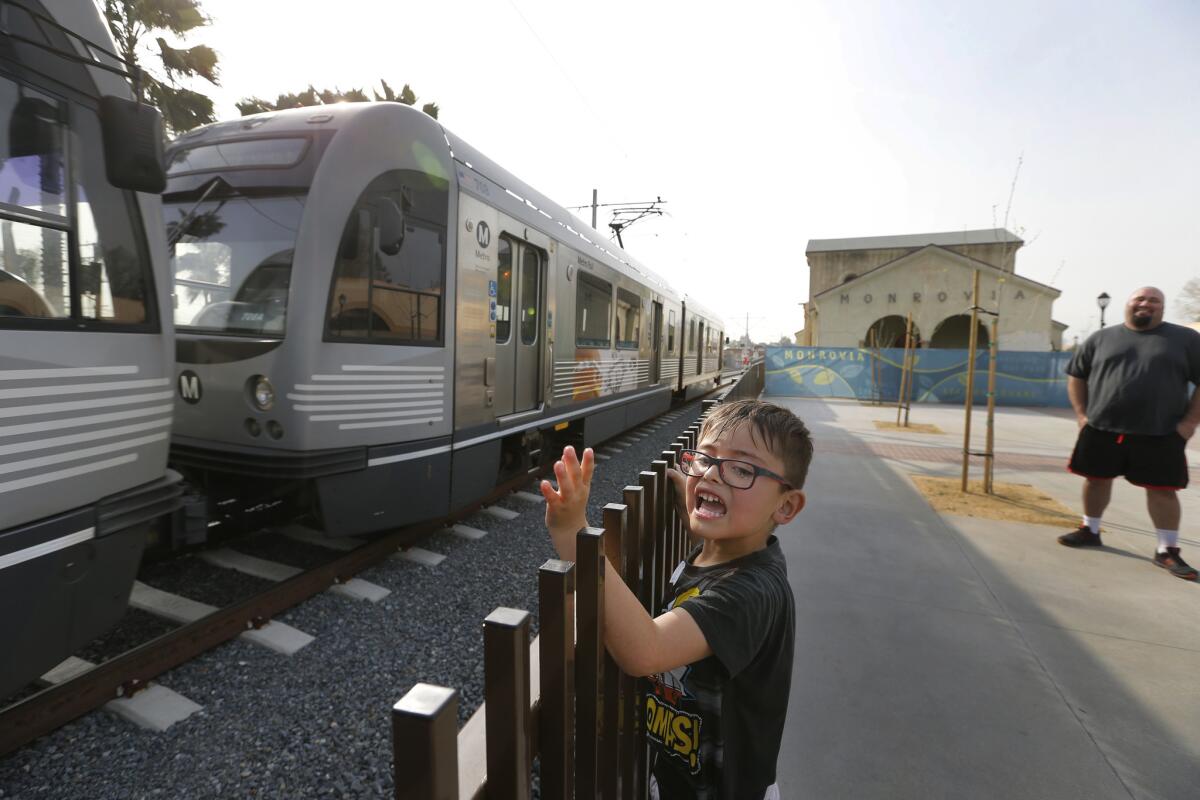Opinion: With Gold Line opening, Metro needs to see what’s driving millennials to hop on board

Train lover Joshua Cota, 6, of Baldwin Park, waves as the new Metro Gold Line extension passes by during testing at the new Monrovia Station Square on March 2.
It’s finally happening.
Metro’s much-anticipated 11.5-mile extension of the Gold Line, stretching from East Pasadena to Azusa, is officially opening this weekend. In only two months, the Expo Line extension to the Santa Monica beach makes its debut. In the years to come, the new Crenshaw-LAX line, the “Subway to the Sea” under Wilshire, as well as various other regional developments, will give Los Angeles one of the most comprehensive public transit networks in America.
I’m a millennial college student — and if national trends are to be believed, I should be thrilled at this impending feast of transit options.
Millennials are the force behind the nation’s shift to lower driving rates. A third of millennials list public transit availability as a top factor in choosing where to live. Ride San Francisco’s Bay Area Rapid Transit or New York City’s subway and you’ll see no shortage of young people. In Seattle, where I’m from, teens and twentysomethings regularly hop on the bus downtown to avoid parking fees and the stress of driving in traffic.
Metro is hopeful that the $12 billion it expects to spend over the next decade will get young Angelenos like me out of their cars and stem the recent tide of declining ridership. After all, by the time L.A.’s grand transit plans finally come to fruition, we’re the ones who will be doing the commuting.
But I have to admit, despite my generation’s embrace of public transit, I’m skeptical about whether we’ll be on board with L.A.’s mass transit plans. My experience in this city tells me young Angelenos — even transplants like myself — ride public transit, but only as a last resort.
Something about L.A. is different.
During my first week of college four years ago, I tried to rally friends to take the $1.25 Big Blue Bus to Santa Monica with me. The few who agreed, after insisting that the system was unreliable and not worth it, stood stiff on the bus, uncomfortable sharing space.
Would the convenience of an expanded rail network change minds about the suitability of the city’s transit? I called around to students at four local universities to see.
Austin Bruns, a 20-year-old film production major at Loyola Marymount, took his first ride on L.A. public transit last summer, when he had an internship in Culver City. Bruns didn’t have a car at the time, so he found two buses he could take from Westchester to his office every day. Online estimates told him the trip would take 40 minutes, just 20 minutes more than the projected driving time.
He was optimistic — the internship experience was worth the long commute. But with the wait time and scheduling inconsistency of the buses, his trek took two hours each day.
“There were days that I would come to work close to an hour late because of the bus not being there on the times it said it was,” Bruns said.
The experience soured him on public transit in L.A.
Now a junior, Bruns has a car. With the stability of driving, he’s been able to extend his work hours. Plus, gas is less expensive than his bus tickets were.
Azusa Pacific University students I spoke with, on the other hand, were excited about their new Gold Line station. Scott Ecklund, a 23-year-old MBA student, said it will mobilize him to travel to L.A. and Pasadena more often.
Will that be true a year from now, however? Despite an initial buzz around the Expo Line when it first opened in 2012, Abby Slovick, a 22-year-old USC student, said she now drives her car to work and elsewhere.
Most students without cars “would rather just Uber,” Slovick said.
At UCLA, 20-year-old psychology major Melissa Zuluaga doesn’t have a car — but she only takes public transit if she has exhausted all other options.
“If transportation got more modern, like 3G Wi-Fi in the bus, or nicer seats,” she said, “I feel like millennials would start using it more.”
Even though I still take public transit when I visit my hometown of Seattle, I’ve used it very seldom in L.A. since my freshman year experiment with the Big Blue Bus. For me, the appeal of a transit system is its efficiency. If Metro could guarantee consistent arrival times and solutions that could beat car traffic, I’d happily use its services.
Whatever millennials need from a transit system — whether it’s real-time updates, convenient stops, price incentives or Wi-Fi — Metro would be wise to tune into it. If Metro planners can’t hack the needs of college-age Angelenos now, it doesn’t bode well for L.A.’s transit future.
Follow the Opinion section on Twitter @latimesopinion and Facebook.
MORE FROM OPINION
How to boost L.A.’s sinking transit ridership
L.A.’s bike-share program is being set up to fail
Connecting Crenshaw and Beverly Hills takes more than a subway line
More to Read
A cure for the common opinion
Get thought-provoking perspectives with our weekly newsletter.
You may occasionally receive promotional content from the Los Angeles Times.










